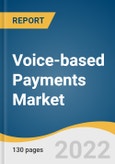Chapter 1 Methodology and Scope
1.1 Research Methodology
1.2 Research Scope and Assumptions
1.3 List of Data Sources
Chapter 2 Executive Summary
2.1 Voice-based Payments Market-Industry Snapshot & Key Buying Criteria, 2017-2030
2.2 Global Voice-based Payments Market, 2017-2030
2.2.1 Global voice-based payments market, by region, 2017-2030
2.2.2 Global voice-based payments market, by component, 2017-2030
2.2.3 Global voice-based payments market, by enterprise size, 2017-2030
2.2.4 Global voice-based payments market, by End-Use, 2017-2030
Chapter 3 Voice-based Payments Industry Outlook
3.1 Market Segmentation and Scope
3.2 Market Size and Growth Prospects
3.3 Voice-based Payments Market-Value Chain Analysis
3.4 Voice-based Payments Market-Market Dynamics
3.4.1 Market driver analysis
3.4.1.1 Increasing demand for contactless payments
3.4.1.2 Rising demand for voice assistant-enabled devices
3.4.2 Market challenge analysis
3.4.2.1 Security issues associated with voice-based payments
3.5 Penetration and Growth Prospect Mapping
3.6 Voice-based Payments Market-Porter’s Five Forces Analysis
3.7 Voice-based Payments Market-PESTEL Analysis
Chapter 4 FinTech Industry Highlights
4.1 Investor Strategies
4.2 Investor Vision & Goal Analysis
4.3 Funding Raised in Voice Assistant Devices
4.4 Investments Made in Self-checkout Stores
Chapter 5 Investment Landscape Analysis
5.1 FinTech Ecosystem Overview
5.2 FinTech Services Overview
5.3 Total FinTech Investment, 2017 - 2021(USD Billion)
5.4 FinTech Regulatory Outlook
- Government Regulations
- Private/Association Regulations
5.5 FinTech Company Analysis-GVR DashBoard (Top 50 companies)
Chapter 6 Voice-based Payments Component Outlook
6.1 Voice-based Payments Market Share by Component, 2021
6.2 Software
6.2.1 Software voice-based payments market, 2017-2030
6.3 Hardware
6.3.1 Hardware voice-based payments market, 2017-2030
Chapter 7 Voice-based Enterprise Size Outlook
7.1 Voice-based Payments Market Share by Enterprise Size, 2021
7.2 Large Enterprises
7.2.1 Voice-based payments market in large enterprises, 2017-2030
7.3 Small & Medium Enterprises
7.3.1 Voice-based payments market in small & medium enterprises, 2017-2030
Chapter 8 Voice-based Payments End-Use Outlook
8.1 Voice-based Payments Market Share by End-Use, 2021
8.2 BFSI
8.2.1 Voice-based payments market in BFSI, 2017-2030
8.3 Automotive
8.3.1 Voice-based payments market in automotive, 2017-2030
8.4 Healthcare
8.4.1 Voice-based payments market in healthcare, 2017-2030
8.5 Retail
8.5.1 Voice-based payments market in retail, 2017-2030
8.6 Government
8.6.1 Voice-based payments market in government, 2017-2030
8.7 Others
8.7.1 Voice-based payments market in others, 2017-2030
Chapter 9 Voice-based Payments Regional Outlook
9.1 Voice-based Payments Market Share by Region, 2021
9.2 North America
9.2.1 North America voice-based payments market, 2017-2030
9.2.2 North America voice-based payments market, by component, 2017-2030
9.2.3 North America voice-based payments market, by enterprise size, 2017-2030
9.2.4 North America voice-based payments market, by End-Use, 2017-2030
9.2.5 U.S.
9.2.5.1 U.S. voice-based payments market, 2017-2030
9.2.5.2 U.S. voice-based payments market, by component, 2017-2030
9.2.5.3 U.S. voice-based payments market, by enterprise size, 2017-2030
9.2.5.4 U.S. voice-based payments market, by End-Use, 2017-2030
9.2.6 Canada
9.2.6.1 Canada voice-based payments market, 2017-2030
9.2.6.2 Canada voice-based payments market, by component, 2017-2030
9.2.6.3 Canada voice-based payments market, by enterprise size, 2017-2030
9.2.6.4 Canada voice-based payments market, by End-Use, 2017-2030
9.3 Europe
9.3.1 Europe voice-based payments market, 2017-2030
9.3.2 Europe voice-based payments market, by component, 2017-2030
9.3.3 Europe voice-based payments market, by enterprise size, 2017-2030
9.3.4 Europe voice-based payments market, by End-Use, 2017-2030
9.3.5 Germany
9.3.5.1 Germany voice-based payments market, 2017-2030
9.3.5.2 Germany voice-based payments market, by component, 2017-2030
9.3.5.3 Germany voice-based payments market, by enterprise size, 2017-2030
9.3.5.4 Germany voice-based payments market, by End-Use, 2017-2030
9.3.6 U.K.
9.3.6.1 U.K. voice-based payments market, 2017-2030
9.3.6.2 U.K. voice-based payments market, by component, 2017-2030
9.3.6.3 U.K. voice-based payments market, by enterprise size, 2017-2030
9.3.6.4 U.K. voice-based payments market, by End-Use, 2017-2030
9.4 Asia Pacific
9.4.1 Asia Pacific voice-based payments market, 2017-2030
9.4.2 Asia Pacific voice-based payments market, by component, 2017-2030
9.4.3 Asia Pacific voice-based payments market, by enterprise size, 2017-2030
9.4.4 Asia Pacific voice-based payments market, by End-Use, 2017-2030
9.4.5 China
9.4.5.1 China voice-based payments market, 2017-2030
9.4.5.2 China voice-based payments market, by component, 2017-2030
9.4.5.3 China voice-based payments market, by enterprise size, 2017-2030
9.4.5.4 China voice-based payments market, by End-Use, 2017-2030
9.4.6 India
9.4.6.1 India voice-based payments market, 2017-2030
9.4.6.2 India voice-based payments market, by component, 2017-2030
9.4.6.3 India voice-based payments market, by enterprise size, 2017-2030
9.4.6.4 India voice-based payments market, by End-Use, 2017-2030
9.4.7 Japan
9.4.7.1 Japan voice-based payments market, 2017-2030
9.4.7.2 Japan voice-based payments market, by component, 2017-2030
9.4.7.3 Japan voice-based payments market, by enterprise size, 2017-2030
9.4.7.4 Japan voice-based payments market, by End-Use, 2017-2030
9.5 Latin America
9.5.1 Latin America voice-based payments market, 2017-2030
9.5.2 Latin America voice-based payments market, by component, 2017-2030
9.5.3 Latin America voice-based payments market, by enterprise size, 2017-2030
9.5.4 Latin America voice-based payments market, by End-Use, 2017-2030
9.5.5 Brazil
9.5.5.1 Brazil voice-based payments market, 2017-2030
9.5.5.2 Brazil voice-based payments market, by component, 2017-2030
9.5.5.3 Brazil voice-based payments market, by enterprise size, 2017-2030
9.5.5.4 Brazil voice-based payments market, by End-Use, 2017-2030
9.6 MEA
9.6.1 MEA voice-based payments market, 2017-2030
9.6.2 MEA voice-based payments market, by component, 2017-2030
9.6.3 MEA voice-based payments market, by enterprise size, 2017-2030
9.6.4 MEA voice-based payments market, by End-Use, 2017-2030
Chapter 10 Competitive Analysis
10.1 Recent Developments & Impact Analysis, by Key Market Participants
10.2 Company Categorization
10.3 Vendor Landscape
10.3.1 Key company market share analysis, 2021
10.4 Company Analysis Tools
10.4.1 Company market position analysis
10.4.2 Competitive dashboard analysis
Chapter 11 Competitive Landscape
11.1 NCR Corporation
11.1.1 Company overview
11.1.2 Financial performance
11.1.3 Product benchmarking
11.1.4 Strategic initiatives
11.2 Amazon.com, Inc.
11.2.1 Company overview
11.2.2 Financial performance
11.2.3 Product benchmarking
11.2.4 Strategic initiatives
11.3 PayPal
11.3.1 Company overview
11.3.2 Financial performance
11.3.3 Product benchmarking
11.3.4 Strategic initiatives
11.4 Paysafe
11.4.1 Company overview
11.4.2 Financial performance
11.4.3 Product benchmarking
11.4.4 Strategic initiatives
11.5 PCI Pal
11.5.1 Company overview
11.5.2 Financial performance
11.5.3 Product benchmarking
11.5.4 Strategic initiatives
11.6 Vibepay
11.6.1 Company overview
11.6.2 Financial performance
11.6.3 Product benchmarking
11.6.4 Strategic initiatives
11.7 Cerence
11.7.1 Company overview
11.7.2 Financial performance
11.7.3 Product benchmarking
11.7.4 Strategic initiatives
11.8 Huawei Technologies Co., Ltd.
11.8.1 Company overview
11.8.2 Financial performance
11.8.3 Product benchmarking
11.8.4 Strategic initiatives
11.9 Google
11.9.1 Company overview
11.9.2 Financial performance
11.9.3 Product benchmarking
11.9.4 Strategic initiatives
11.10 Alibaba
11.10.1 Company overview
11.10.2 Financial performance
11.10.3 Product benchmarking
11.10.4 Strategic initiatives









